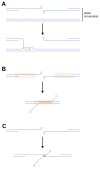Double strand break repair functions of histone H2AX
- PMID: 23916969
- PMCID: PMC3818383
- DOI: 10.1016/j.mrfmmm.2013.07.007
Double strand break repair functions of histone H2AX
Abstract
Chromosomal double strand breaks provoke an extensive reaction in neighboring chromatin, characterized by phosphorylation of histone H2AX on serine 139 of its C-terminal tail (to form "γH2AX"). The γH2AX response contributes to the repair of double strand breaks encountered in a variety of different contexts, including those induced by ionizing radiation, physiologically programmed breaks that characterize normal immune cell development and the pathological exposure of DNA ends triggered by telomere dysfunction. γH2AX also participates in the evolutionarily conserved process of sister chromatid recombination, a homologous recombination pathway involved in the suppression of genomic instability during DNA replication and directly implicated in tumor suppression. At a biochemical level, the γH2AX response provides a compelling example of how the "histone code" is adapted to the regulation of double strand break repair. Here, we review progress in research aimed at understanding how γH2AX contributes to double strand break repair in mammalian cells.
Keywords: 53BP1; BRCA1; H2AX; Histone code; Homologous recombination; MDC1; Mammalian DSB repair; Mre11/Rad50/Nbs1; Non-homologous end joining; Single strand annealing.
Copyright © 2013 Elsevier B.V. All rights reserved.
Figures



References
-
- Chapman JR, Taylor MR, Boulton SJ. Playing the end game: DNA double-strand break repair pathway choice. Mol Cell. 2012;47:497–510. - PubMed
Publication types
MeSH terms
Substances
Grants and funding
LinkOut - more resources
Full Text Sources
Other Literature Sources
Research Materials
Miscellaneous

